Page 57 of 90
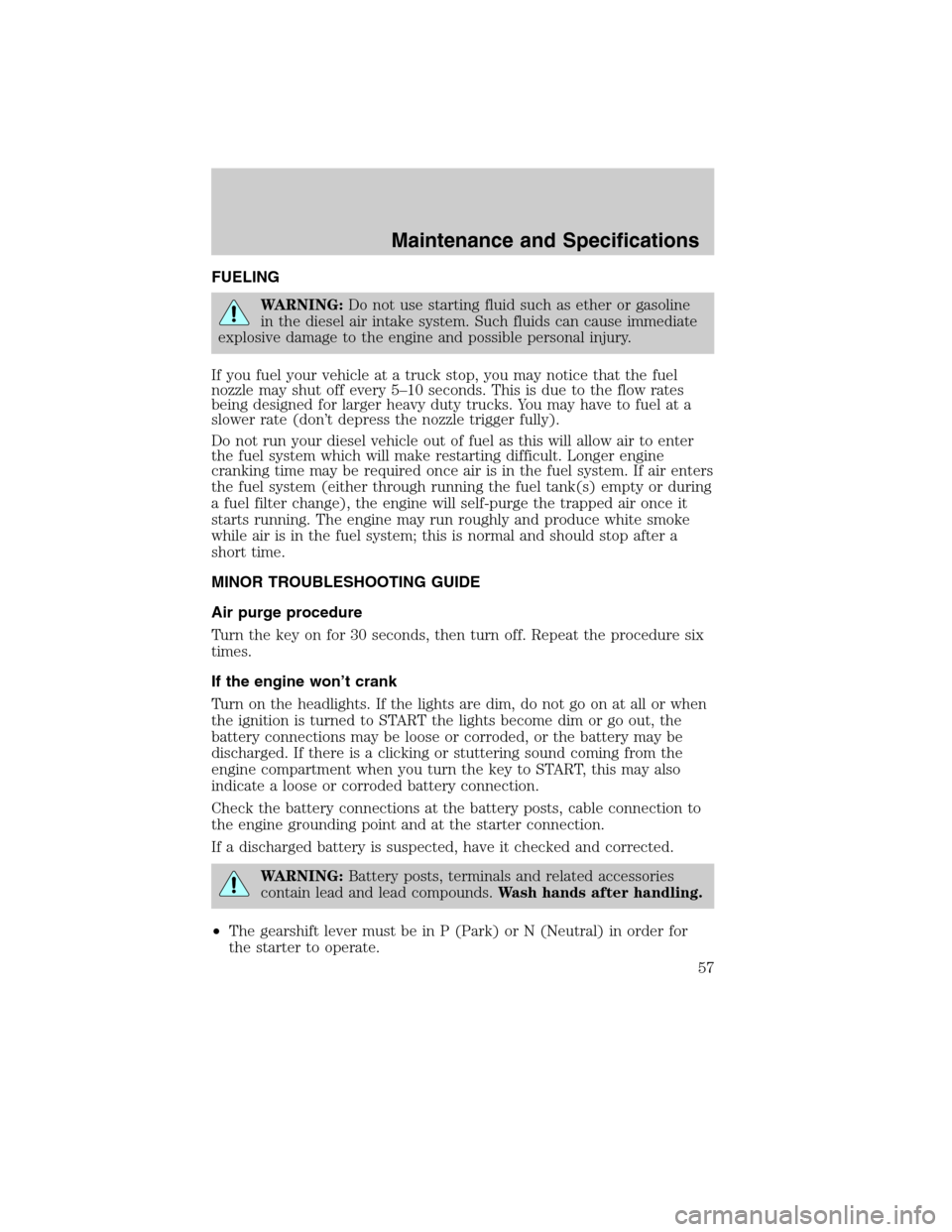
FUELING
WARNING:Do not use starting fluid such as ether or gasoline
in the diesel air intake system. Such fluids can cause immediate
explosive damage to the engine and possible personal injury.
If you fuel your vehicle at a truck stop, you may notice that the fuel
nozzle may shut off every 5–10 seconds. This is due to the flow rates
being designed for larger heavy duty trucks. You may have to fuel at a
slower rate (don’t depress the nozzle trigger fully).
Do not run your diesel vehicle out of fuel as this will allow air to enter
the fuel system which will make restarting difficult. Longer engine
cranking time may be required once air is in the fuel system. If air enters
the fuel system (either through running the fuel tank(s) empty or during
a fuel filter change), the engine will self-purge the trapped air once it
starts running. The engine may run roughly and produce white smoke
while air is in the fuel system; this is normal and should stop after a
short time.
MINOR TROUBLESHOOTING GUIDE
Air purge procedure
Turn the key on for 30 seconds, then turn off. Repeat the procedure six
times.
If the engine won’t crank
Turn on the headlights. If the lights are dim, do not go on at all or when
the ignition is turned to START the lights become dim or go out, the
battery connections may be loose or corroded, or the battery may be
discharged. If there is a clicking or stuttering sound coming from the
engine compartment when you turn the key to START, this may also
indicate a loose or corroded battery connection.
Check the battery connections at the battery posts, cable connection to
the engine grounding point and at the starter connection.
If a discharged battery is suspected, have it checked and corrected.
WARNING:Battery posts, terminals and related accessories
contain lead and lead compounds.Wash hands after handling.
•The gearshift lever must be in P (Park) or N (Neutral) in order for
the starter to operate.
Maintenance and Specifications
57
2011 Econoline(eco)
Supplement, 1st Printing
USA(fus)
Page 58 of 90

•Try operating the starter switch several times. Should the switch be
corroded, this operation may clean the contacts or make the switch
temporarily operable until you can reach the dealer.
•If all electrical connections are tight and you need assistance to start,
refer toJump startingin theRoadside Emergencieschapter of your
Owner’s Guide.
If engine cranks but won’t start
Prolonged starter cranking (in excess of 10 seconds) could cause
damage to the starter motor.
•Check the fuel gauge. You may be out of fuel. If the gauge shows that
there is fuel in the tank, the trouble may be in the electrical system or
the fuel system. If equipped with an auxiliary tank, be sure that the
tank control switch is set for the tank with fuel and not on an empty
tank.
•Leaving the ignition key turned to on for over two minutes without
starting may make starting difficult because the glow plugs will cease
activation. Reset the system by turning the ignition key to off and
then back to on again.
If the engine runs hot
The following could cause the engine to overheat:
•Lack of coolant.
•Dirty cooling system.
•Plugged radiator fins, A/C condenser and/or oil cooler.
•Malfunctioning fan drive.
•Driving with frozen coolant.
•Sticking thermostat.
•Overloading or pulling heavy trailers during hot weather.
•Grill or radiator air blockage.
•Slipping or missing drive belt.
•Plugged or very dirty air filter.
Maintenance and Specifications
58
2011 Econoline(eco)
Supplement, 1st Printing
USA(fus)
Page 59 of 90
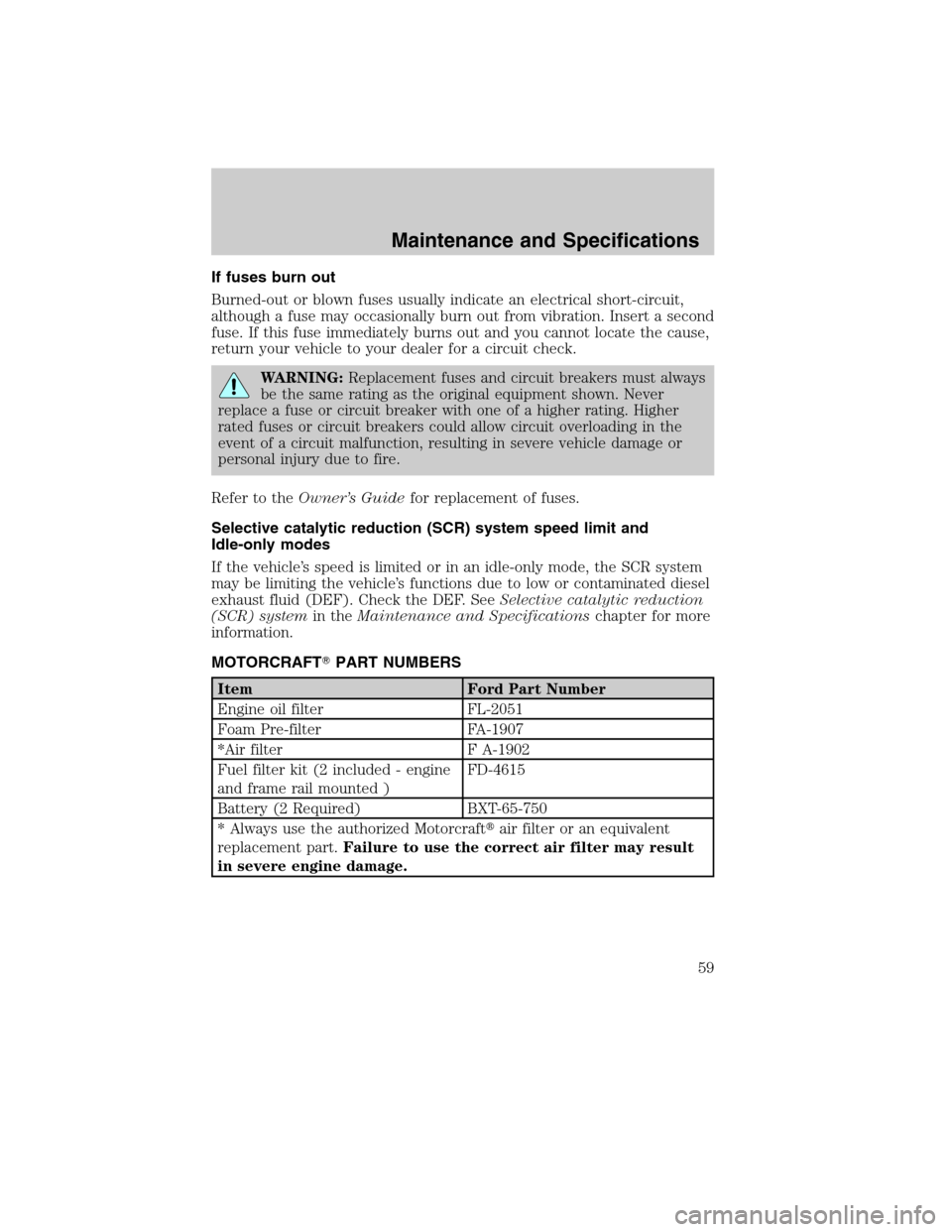
If fuses burn out
Burned-out or blown fuses usually indicate an electrical short-circuit,
although a fuse may occasionally burn out from vibration. Insert a second
fuse. If this fuse immediately burns out and you cannot locate the cause,
return your vehicle to your dealer for a circuit check.
WARNING:Replacement fuses and circuit breakers must always
be the same rating as the original equipment shown. Never
replace a fuse or circuit breaker with one of a higher rating. Higher
rated fuses or circuit breakers could allow circuit overloading in the
event of a circuit malfunction, resulting in severe vehicle damage or
personal injury due to fire.
Refer to theOwner’s Guidefor replacement of fuses.
Selective catalytic reduction (SCR) system speed limit and
Idle-only modes
If the vehicle’s speed is limited or in an idle-only mode, the SCR system
may be limiting the vehicle’s functions due to low or contaminated diesel
exhaust fluid (DEF). Check the DEF. SeeSelective catalytic reduction
(SCR) systemin theMaintenance and Specificationschapter for more
information.
MOTORCRAFT�PART NUMBERS
Item Ford Part Number
Engine oil filter FL-2051
Foam Pre-filter FA-1907
*Air filter F A-1902
Fuel filter kit (2 included - engine
and frame rail mounted )FD-4615
Battery (2 Required) BXT-65-750
* Always use the authorized Motorcraft�air filter or an equivalent
replacement part.Failure to use the correct air filter may result
in severe engine damage.
Maintenance and Specifications
59
2011 Econoline(eco)
Supplement, 1st Printing
USA(fus)
Page 60 of 90
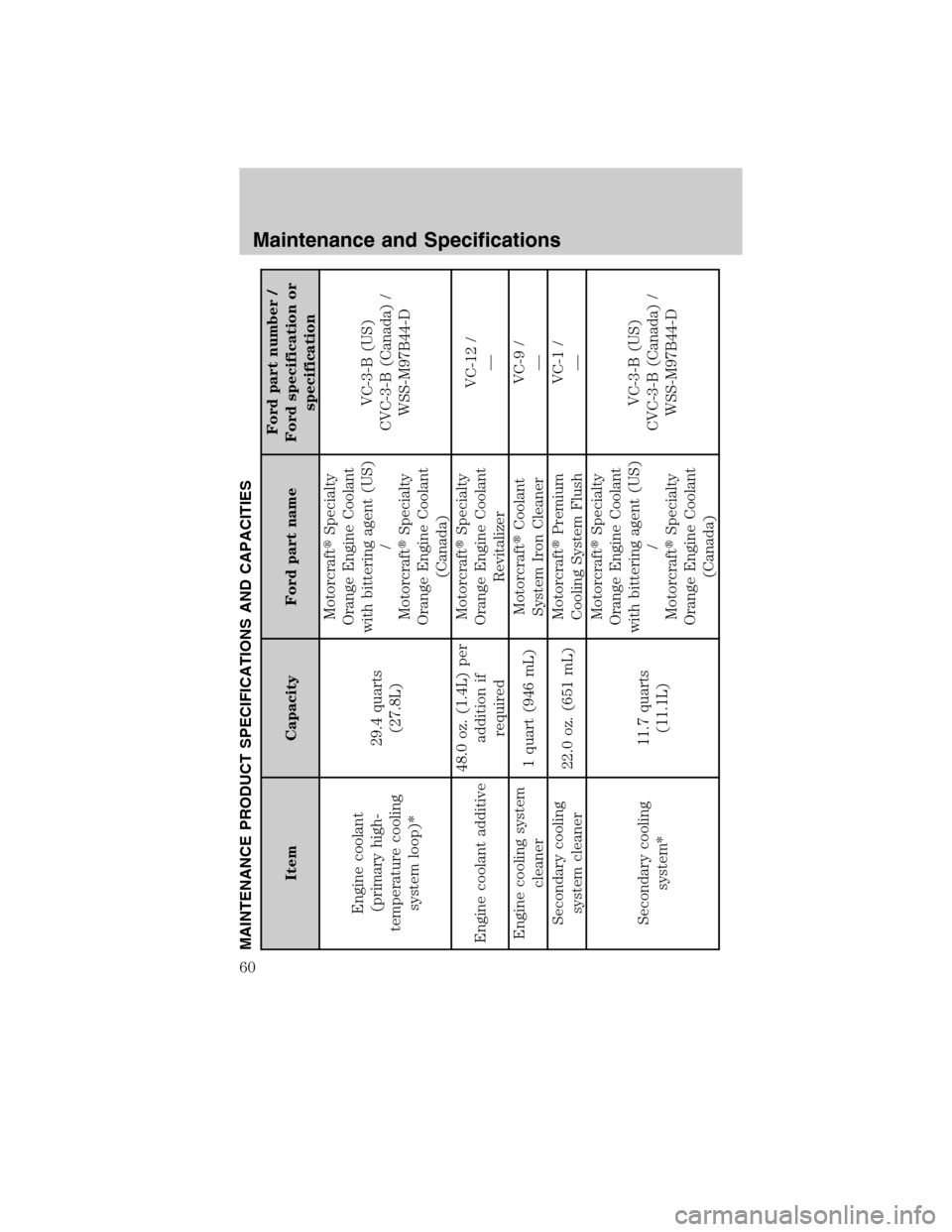
MAINTENANCE PRODUCT SPECIFICATIONS AND CAPACITIES
Item Capacity Ford part nameFord part number /
Ford specification or
specification
Engine coolant
(primary high-
temperature cooling
system loop)*29.4 quarts
(27.8L)Motorcraft�Specialty
Orange Engine Coolant
with bittering agent (US)
/
Motorcraft�Specialty
Orange Engine Coolant
(Canada)VC-3-B (US)
CVC-3-B (Canada) /
WSS-M97B44-D
Engine coolant additive48.0 oz. (1.4L) per
addition if
requiredMotorcraft�Specialty
Orange Engine Coolant
RevitalizerVC-12 /
—
Engine cooling system
cleaner1 quart (946 mL)Motorcraft�Coolant
System Iron CleanerVC-9 /
—
Secondary cooling
system cleaner22.0 oz. (651 mL)Motorcraft�Premium
Cooling System FlushVC-1 /
—
Secondary cooling
system*11.7 quarts
(11.1L)Motorcraft�Specialty
Orange Engine Coolant
with bittering agent (US)
/
Motorcraft�Specialty
Orange Engine Coolant
(Canada)VC-3-B (US)
CVC-3-B (Canada) /
WSS-M97B44-D
Maintenance and Specifications
60
2011 Econoline(eco)
Supplement, 1st Printing
USA(fus)
Page 61 of 90
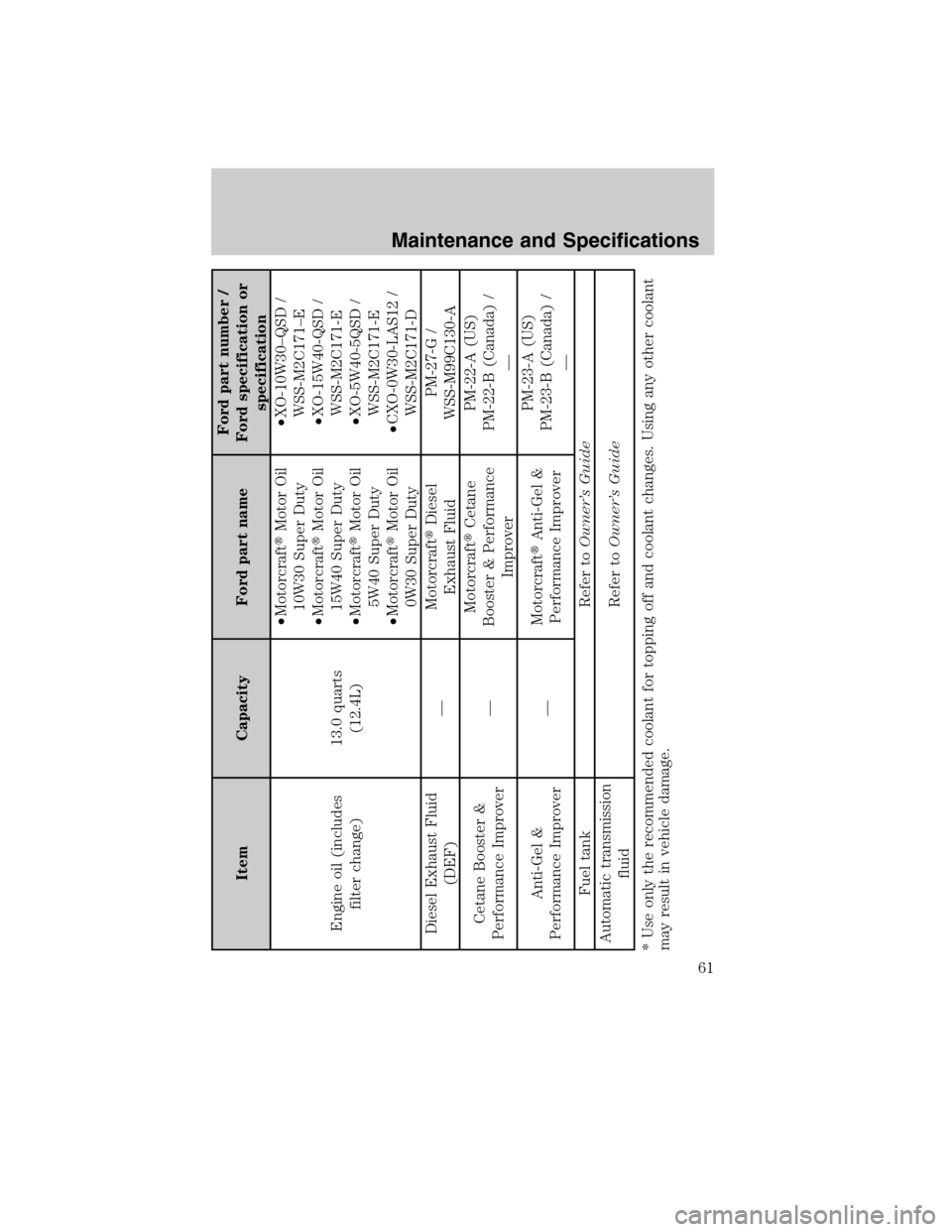
Item Capacity Ford part nameFord part number /
Ford specification or
specification
Engine oil (includes
filter change)13.0 quarts
(12.4L)•Motorcraft�Motor Oil
10W30 Super Duty
•Motorcraft�Motor Oil
15W40 Super Duty
•Motorcraft�Motor Oil
5W40 Super Duty
•Motorcraft�Motor Oil
0W30 Super Duty•XO-10W30–QSD /
WSS-M2C171–E
•XO-15W40-QSD /
WSS-M2C171-E
•XO-5W40-5QSD /
WSS-M2C171-E
•CXO-0W30-LAS12 /
WSS-M2C171-D
Diesel Exhaust Fluid
(DEF)—Motorcraft�Diesel
Exhaust FluidPM-27-G /
WSS-M99C130-A
Cetane Booster &
Performance Improver—Motorcraft�Cetane
Booster & Performance
ImproverPM-22-A (US)
PM-22-B (Canada) /
—
Anti-Gel &
Performance Improver—Motorcraft�Anti-Gel &
Performance ImproverPM-23-A (US)
PM-23-B (Canada) /
—
Fuel tank Refer toOwner’s Guide
Automatic transmission
fluidRefer toOwner’s Guide
* Use only the recommended coolant for topping off and coolant changes. Using any other coolant
may result in vehicle damage.
Maintenance and Specifications
61
2011 Econoline(eco)
Supplement, 1st Printing
USA(fus)
Page 62 of 90
ENGINE DRIVEBELT ROUTING
Single Alternator
Dual Alternator
Maintenance and Specifications
62
2011 Econoline(eco)
Supplement, 1st Printing
USA(fus)
Page 63 of 90
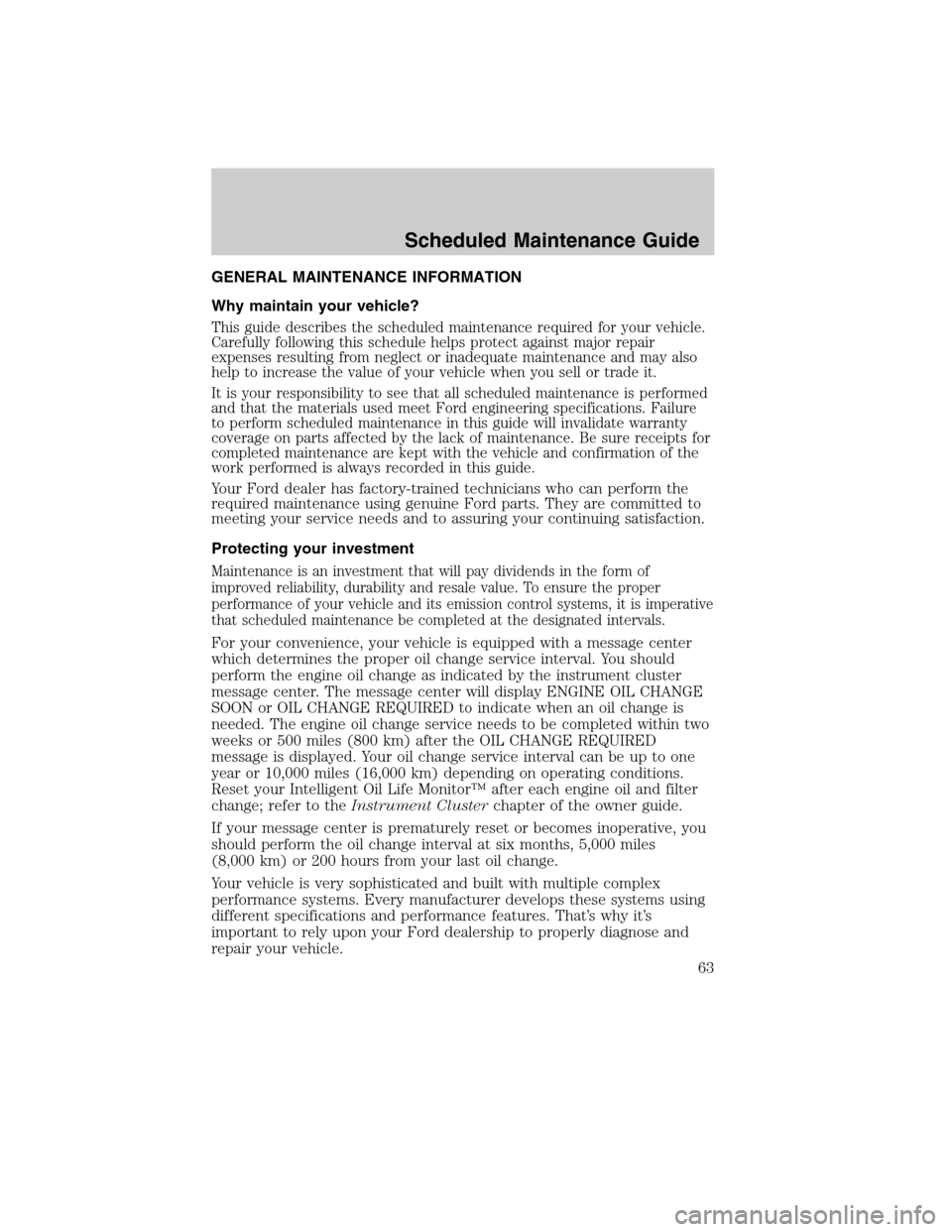
GENERAL MAINTENANCE INFORMATION
Why maintain your vehicle?
This guide describes the scheduled maintenance required for your vehicle.
Carefully following this schedule helps protect against major repair
expenses resulting from neglect or inadequate maintenance and may also
help to increase the value of your vehicle when you sell or trade it.
It is your responsibility to see that all scheduled maintenance is performed
and that the materials used meet Ford engineering specifications. Failure
to perform scheduled maintenance in this guide will invalidate warranty
coverage on parts affected by the lack of maintenance. Be sure receipts for
completed maintenance are kept with the vehicle and confirmation of the
work performed is always recorded in this guide.
Your Ford dealer has factory-trained technicians who can perform the
required maintenance using genuine Ford parts. They are committed to
meeting your service needs and to assuring your continuing satisfaction.
Protecting your investment
Maintenance is an investment that will pay dividends in the form of
improved reliability, durability and resale value. To ensure the proper
performance of your vehicle and its emission control systems, it is imperative
that scheduled maintenance be completed at the designated intervals.
For your convenience, your vehicle is equipped with a message center
which determines the proper oil change service interval. You should
perform the engine oil change as indicated by the instrument cluster
message center. The message center will display ENGINE OIL CHANGE
SOON or OIL CHANGE REQUIRED to indicate when an oil change is
needed. The engine oil change service needs to be completed within two
weeks or 500 miles (800 km) after the OIL CHANGE REQUIRED
message is displayed. Your oil change service interval can be up to one
year or 10,000 miles (16,000 km) depending on operating conditions.
Reset your Intelligent Oil Life Monitor™ after each engine oil and filter
change; refer to theInstrument Clusterchapter of the owner guide.
If your message center is prematurely reset or becomes inoperative, you
should perform the oil change interval at six months, 5,000 miles
(8,000 km) or 200 hours from your last oil change.
Your vehicle is very sophisticated and built with multiple complex
performance systems. Every manufacturer develops these systems using
different specifications and performance features. That’s why it’s
important to rely upon your Ford dealership to properly diagnose and
repair your vehicle.
Scheduled Maintenance Guide
63
2011 Econoline(eco)
Supplement, 1st Printing
USA(fus)
Page 64 of 90

Ford Motor Company has recommended maintenance intervals for
various parts and component systems based upon engineering testing.
Ford Motor Company relies upon this testing to determine the most
appropriate mileage for replacement of oils and fluids to protect your
vehicle at the lowest overall cost to you and recommends against
maintenance schedules that deviate from the scheduled maintenance
information.
Ford strongly recommends the use of genuine Ford replacement parts.
Parts other than Ford, Motorcraft�or Ford-authorized remanufactured
parts that are used for maintenance replacement or for the service of
components affecting emission control must be equivalent to genuine
Ford Motor Company parts in performance and durability. It is the
owner’s responsibility to determine the equivalency of such parts. Please
consult yourWarranty Guidefor complete warranty information.
Non Ford-approved chemicals or additives are not required for factory
recommended maintenance. In fact, Ford Motor Company recommends
against the use of such additive products unless specifically
recommended by Ford for a particular application.
Oils, fluids and flushing
In many cases, fluid discoloration is a normal operating characteristic of
the chemical compound and may not necessarily demonstrate that a fluid
needs to be changed. Oils and fluids identified in this guide should be
changed at the specified interval or in conjunction with a repair. Flushing
is a viable way to change fluid for many vehicle sub-systems during
scheduled maintenance and should only be done using the same fluid
required to finish the maintenance procedure, or a Ford-approved
flushing chemical.
Genuine Ford parts and service
When planning your maintenance services, consider your Ford dealership
for all your vehicle’s needs.
Get the most from your service and maintenance visits
There are a lot of reasons why your Ford dealership is a great way to
help keep your vehicle running great.
Convenience
To make your service visit even more convenient, in many cases, you’ll
find extended evening hours and Saturday hours. How’s that for quality
service?
Scheduled Maintenance Guide
64
2011 Econoline(eco)
Supplement, 1st Printing
USA(fus)